| Revision as of 08:57, 3 November 2011 view sourceTopGun (talk | contribs)Extended confirmed users, Pending changes reviewers20,007 editsm re added possible mistaken removal of flag. (if there was a different flag please replace.)← Previous edit | Revision as of 12:58, 3 November 2011 view source Zuggernaut (talk | contribs)5,018 edits Removing flag of Azad Kashmi per WP:OR, made accurate per the source, see talk and discuss thereNext edit → | ||
| Line 14: | Line 14: | ||
| | combatant1 = {{flagicon|India}} ]<br/> ] ] <br> | | combatant1 = {{flagicon|India}} ]<br/> ] ] <br> | ||
| | combatant2 = {{flagicon|Pakistan}} ] | | combatant2 = {{flagicon|Pakistan}} ] | ||
| | combatant3 = Non-state tribal ''lashkars'' (militias) backed by the Pakistani state<ref name="(Editor)">{{cite book|author=Robert Blackwill, James Dobbins, Michael O'Hanlon, Clare Lockhart, Nathaniel Fick, Molly Kinder, Andrew Erdmann, John Dowdy, Samina Ahmed, Anja Manuel, Meghan O'Sullivan, Nancy Birdsall, Wren Elhai, Nicholas Burns (Editor), Jonathon Price (Editor)|title=American Interests in South Asia: Building a Grand Strategy in Afghanistan, Pakistan, and India|url=http://books.google.com/books?id=ENyfHXi9wz0C&pg=PT155|accessdate=3 November 2011|publisher=Aspen Institute|isbn=978-1-61792-400-2|pages=155–}}</ref> | |||
| | commander1 = ] ]] <br/>] Lt.Gen. ] <br/>] Maj.Gen. ] <br/>] Maj.Gen. ] | | commander1 = ] ]] <br/>] Lt.Gen. ] <br/>] Maj.Gen. ] <br/>] Maj.Gen. ] | ||
| | commander2 =] ] ]<br>] ] ]<br>] ] ]<br>] ] ] | | commander2 =] ] ]<br>] ] ]<br>] ] ]<br>] ] ] | ||
Revision as of 12:58, 3 November 2011
| This article includes a list of general references, but it lacks sufficient corresponding inline citations. Please help to improve this article by introducing more precise citations. (August 2010) (Learn how and when to remove this message) |
| Indo-Pakistani War of 1947 | ||||||||||
|---|---|---|---|---|---|---|---|---|---|---|
| Part of the Indo-Pakistani Wars | ||||||||||
| ||||||||||
| Belligerents | ||||||||||
|
|
| Non-state tribal lashkars (militias) backed by the Pakistani state | ||||||||
| Commanders and leaders | ||||||||||
|
|
| |||||||||
| Casualties and losses | ||||||||||
|
1,500 killed 3,152 wounded |
1,500 — 2,633 killed 4,668 wounded | |||||||||
| Started when Pashtun tribal forces, and later Indian and Pakistani Army regulars, entered the princely state of Jammu and Kashmir. | ||||||||||
| Indo-Pakistani conflicts | |
|---|---|
| Kashmir conflict
Other conflicts Border skirmishes Strikes |
The India-Pakistan War of 1947-48, sometimes known as the First Kashmir War, was fought between India and Pakistan over the princely state of Kashmir and Jammu from 1947 to 1948. It was the first of four wars fought between the two newly independent nations. The result of the war still affects the geopolitics of both the countries.
The war was initially fought by the forces of the princely state and tribal militias from the Khyber Pakhtunkhwa and Federally Administered Tribal Areas. Facing the assault and a Muslim revolution in the Poonch and Mirpur area , the ruler of princely state of Kashmir and Jammu signed an Instrument of Accession to the Indian union. Indian and Pakistani armies entered the war subsequently. The fronts solidified gradually along what would became known as the Line of Control. A formal cease-fire was declared at 2359 hours on the night of 1/2 January 1949.
Background
Prior to 1815 the area now known as "Jammu and Kashmir" comprised 22 small independent states (16 Hindu and 6 Muslim) carved out of territories controlled by the Afghanistan Amir (King) combined with those of local small rulers. These were collectively referred to as the "Panjab Hill States". These small states, ruled by Rajput kings, were variously independent,vassals of the Mughal Empire since the time of Emperor Akbar or sometimes controlled from Kangra state in the Himachal area.Following the decline of the Mughals,turbulence in Kangra and Gorkha invasions, the hill states fell one by one under the dominance of the Sikhs under Ranjit Singh.
The First Anglo-Sikh War (1845–46) was fought between the Sikh Empire, which asserted sovereignty over Kashmir, and the East India Company. In the Treaty of Lahore in 1846, the Sikhs were made to surrender the valuable region (the Jullundur Doab) between the Beas River and Sutlej River and required to pay an indemnity of 1.2 million rupees. Because they could not readily raise this sum, the East India Company allowed the Dogra ruler Gulab Singh to acquire Kashmir from the Sikh kingdom in exchange for making a payment of 750,000 rupees to the East India Company. Gulab Singh became the first Maharaja of the newly formed princely state of Jammu and Kashmir, founding a dynasty, that was to rule the state, the second-largest principality during the British Raj, until India gained its independence in 1947.
Partition of India
See also: Kashmir conflictBefore and after the withdrawal of the British from India in 1947, the princely state of Kashmir and Jammu came under pressure from both India and Pakistan to agree to become part of one of the newly independent countries. According to the instruments of accession relating to the Partition of India, the rulers of princely states were to be given the choice of either acceding to India or Pakistan. However, the Maharaja of Kashmir, Hari Singh tried to avoid accession to either country. Following a Muslim revolution in the Poonch and Mirpur area and an allegedly Pakistani backed Pashtun tribal intervention from the Khyber Pakhtunkhwa that aimed at supporting the revolution, the Maharaja asked for Indian military assistance. India set a condition that Kashmir must accede to India for it to receive assistance. The Maharaja complied, and the Government of India recognized the accession of the erstwhile princely state to India. Indian troops were sent to the state to defend it. The Jammu & Kashmir National Conference volunteers aided the Indian Army in its campaign to drive out the Pathan invaders. The legitimacy of this accession is still disputed.
Pakistan was of the view that the Maharaja of Kashmir had no right to call in the Indian Army, because it held that the Maharaja of Kashmir was not a heredity ruler, that he was merely a British appointee after the British defeated Ranjit Singh who ruled the province before the British. There had been no such position as the "Maharaja of Kashmir" prior to British rule. Hence Pakistan decided to take action, but the Army Chief of Pakistan General Douglas Gracey did not send troops to the Kashmir front and refused to obey the order to do so given by Muhammad Ali Jinnah, Governor-General of Pakistan. Gracey justified his insubordination by arguing that Indian forces occupying Kashmir represented the British Crown and hence he could not engage in a military encounter with Indian forces. Pakistan finally did manage to send troops to Kashmir but by then the Indian forces had taken control of approximately two thirds of the former principality. The Gilgit and Baltistan territories were secured for Pakistan by the Gilgit Scouts and the forces of the state of Chitral, another princely state that had acceded to Pakistan.
Stages of the war
| This article needs additional citations for verification. Please help improve this article by adding citations to reliable sources. Unsourced material may be challenged and removed. Find sources: "Indo-Pakistani war of 1947–1948" – news · newspapers · books · scholar · JSTOR (November 2011) (Learn how and when to remove this message) |

Initial invasion
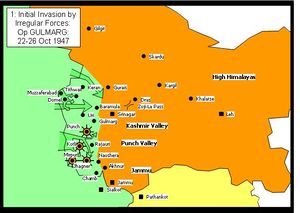
The state forces stationed in the border regions around Muzaffarabad and Domel were quickly defeated by tribal forces (some state forces mutinied and joined the them) and the way to the capital was open. Rather than advancing toward Srinagar before state forces could regroup or be reinforced, the invading forces remained in the captured cities in the border region engaging in looting and other crimes against their inhabitants. In the Poonch valley, the state forces retreated into towns where they were besieged.

Indian operation in the Kashmir Valley
After the accession, India airlifted troops and equipment to Srinagar, where they reinforced the princely state forces, established a defence perimeter and defeated the tribal forces on the outskirts of the city. The successful defence included an outflanking manoeuvre by Indian armoured cars. The defeated tribal forces were pursued as far as Baramulla and Uri and these towns were recaptured.
In the Poonch valley, tribal forces continued to besiege state forces.
In Gilgit, the state paramilitary forces, called the Gilgit Scouts, joined the invading tribal forces, who thereby obtained control of this northern region of the state. The tribal forces were also joined by troops from Chitral, whose ruler, the Mehtar of Chitral, had acceded to Pakistan.

Attempted link-up at Poonch and fall of Mirpur
Indian forces ceased pursuit of tribal forces after recapturing Uri and Baramula, and sent a relief column southwards, in an attempt to relieve Poonch. Although the relief column eventually reached Poonch, the siege could not be lifted. A second relief column reached Kotli, and evacuated the garrisons of that town and others but were forced to abandon it being too weak to defend it. Meanwhile, Mirpur was captured by the tribal forces on the 25th of November 1947.

Fall of Jhanger and attacks on Naoshera and Uri
The tribal forces attacked and captured Jhanger. They then attacked Naoshera unsuccessfully, and made a series of unsuccessful attacks on Uri. In the south a minor Indian attack secured Chamb. By this stage of the war the front line began to stabilize as more Indian troops became available.

Operation Vijay: counterattack to Jhanger
The Indian forces launched a counterattack in the south recapturing Jhanger and Rajauri. In the Kashmir Valley the tribal forces continued attacking the Uri garrison. In the north Skardu was brought under siege by the Gilgit scouts.
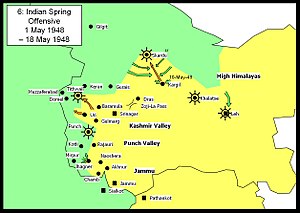
Indian Spring Offensive
The Indians held onto Jhanger against numerous counterattacks, who were increasingly supported by regular Pakistani Forces. In the Kashmir Valley the Indians attacked, recapturing Tithwail. The Gilgit scouts made good progress in the High Himalayas sector, infiltrating troops to bring Leh under siege, capturing Kargil and defeating a relief column heading for Skardu.
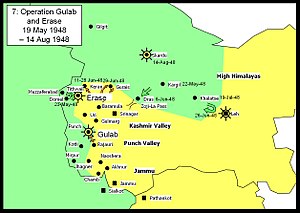
Operations Gulab and Eraze
The Indians continued to attack in the Kashmir Valley sector driving north to capture Keran and Gurais (Operation Eraze). They also repelled a counterattack aimed at Tithwal. In the Jammu region, the forces besieged in Poonch broke out and temporarily linked up with the outside world again. The Kashmir State army was able to defend Skardu from the Gilgit Scouts impeding their advance down the Indus valley towards Leh. In August the Chitral Forces under Mata-ul-Mulk besieged Skardu and with the help of artillery were able to take Skardu. This freed the Gilgit Scouts to push further into Ladakh.
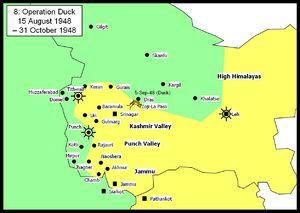
Operation Bison
Main article: Military operations in Ladakh (1948)During this time the front began to settle down. The siege of Poonch continued. An unsuccessful attack was launched by 77 Parachute Brigade (Brig Atal) to capture Zoji La pass. Operation Duck, the earlier epithet for this assault, was renamed as Operation Bison by Cariappa. M5 Stuart light tanks of 7 Cavalry were moved in dismantled conditions through Srinagar and winched across bridges while two field companies of the Madras Sappers converted the mule track across Zoji La into a jeep track. The surprise attack on 1 November by the brigade with armour supported by two regiments of 25 pounders and a regiment of 3.7 inch guns, forced the pass and pushed the tribal/Pakistani forces back to Matayan and later Dras. The brigade linked up on 24 November at Kargil with Indian troops advancing from Leh while their opponents eventually withdrew northwards toward Skardu.

Operation Easy; Poonch link-up
Main article: Military operations in Poonch (1948)The Indians now started to get the upper hand in all sectors. Poonch was finally relieved after a siege of over a year. The Gilgit forces in the High Himalayas, who had previously made good progress, were finally defeated. The Indians pursued as far as Kargil before being forced to halt due to supply problems. The Zoji La pass was forced by using tanks (which had not been thought possible at that altitude) and Dras was recaptured.
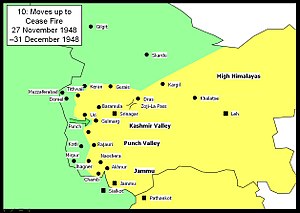
Moves up to cease-fire
At this stage Indian Prime Minister Jawaharlal Nehru decided to ask UN to intervene. A UN cease-fire was arranged for the 31 December 1948. A few days before the cease-fire the Pakistanis launched a counter attack, which cut the road between Uri and Poonch. After protracted negotiations a cease-fire was agreed to by both countries, which came into effect. The terms of the cease-fire as laid out in a United Nations resolution of August 13, 1948, were adopted by the UN on January 5, 1949. This required Pakistan to withdraw its forces, both regular and irregular, while allowing India to maintain minimum strength of its forces in the state to preserve law and order. On compliance of these conditions a plebiscite was to be held to determine the future of the territory. In all, 1,500 soldiers died on each side during the war and Pakistan was able to acquire roughly two-fifths of Kashmir, including five of the fourteen eight thousanders plus peaks of the world, while India maintained the remaining three fifths of Kashmir, including the most populous and fertile regions.
See also
Notes
- Robert Blackwill, James Dobbins, Michael O'Hanlon, Clare Lockhart, Nathaniel Fick, Molly Kinder, Andrew Erdmann, John Dowdy, Samina Ahmed, Anja Manuel, Meghan O'Sullivan, Nancy Birdsall, Wren Elhai, Nicholas Burns (Editor), Jonathon Price (Editor). American Interests in South Asia: Building a Grand Strategy in Afghanistan, Pakistan, and India. Aspen Institute. pp. 155–. ISBN 978-1-61792-400-2. Retrieved 3 November 2011.
{{cite book}}:|author=has generic name (help)CS1 maint: multiple names: authors list (link) - ^ Library of Congress Country Studies
- Official Government of India Statement giving numbers of KIA - Parliament of India Website
- ^ Battle Casualties of Azad Kashmir Regiment during 1947-1948
- ^ Kashmir. (2011). In Encyclopædia Britannica. Retrieved from http://www.britannica.com/EBchecked/topic/312908/Kashmir
- ^ Lamb, Alastair (1997), Incomplete partition: the genesis of the Kashmir dispute 1947-1948, Roxford, ISBN=0907129080}}
- ^ Prasad, S.N.; Dharm Pal (1987). History of Operations In Jammu and Kashmir 1947-1948. New Delhi: History Department, Ministry of Defence, Government of India. (printed at Thomson Press (India) Limited). p. 418..
- Hutchison, J.; Vogel, Jean Philippe (1933). History of the Panjab Hill States. Superint., Gov. Print., Punjab. Retrieved 23 October 2011.
- Srinagar www.collectbritain.co.uk.
- Kashmir-konflikten. (2011-10-18) I Store norske leksikon. Taken from http://snl.no/Kashmir-konflikten
- Norwegian Broadcasting Corporation: Kashmir-konflikten
- "My Life and Times". Allied Publishers Limited. Retrieved 2010-07-01.
- Srinagar www.collectbritain.co.uk.
- I Indo-Pakistani War, 1947-1949 By Tom Cooper Air Combat Information Group October 29, 2003
- Sinha, Lt. Gen. S.K. (1977). Operation Rescue:Military Operations in Jammu & Kashmir 1947-49. New Delhi: Vision Books. p. 174. ISBN 81-7094-012-5. Retrieved 4 August 2010.
- Resolution adopted by the United Nations Commission for India and Pakistan on 13 August 1948
- Global security
Bibliography
- Major sources
- Ministry of Defence, Government of India. Operations In Jammu and Kashmir 1947-1948. (1987). Thomson Press (India) Limited, New Delhi. This is the Indian Official History.
- Lamb, Alastair. Kashmir: A Disputed Legacy, 1846-1990. (1991). Roxford Books. ISBN 0-907129-06-4.
- Praval, K.C. The Indian Army After Independence. (1993). Lancer International, ISBN 1-897829-45-0
- Sen, Maj Gen L.P. Slender Was The Thread: The Kashmir confrontation 1947-1948. (1969). Orient Longmans Ltd, New Delhi.
- Vas, Lt Gen. E. A. Without Baggage: A personal account of the Jammu and Kashmir Operations 1947-1949. (1987). Natraj Publishers Dehradun. ISBN 81-85019-09-6.
- Other sources
- Cohen, Lt Col Maurice. Thunder over Kashmir. (1955). Orient Longman Ltd. Hyderabad
- Hinds, Brig Gen SR. Battle of Zoji La. (1962). Military Digest, New Delhi.
- Sandhu, Maj Gen Gurcharan. The Indian Armour: History Of The Indian Armoured Corps 1941-1971. (1987). Vision Books Private Limited, New Delhi, ISBN 81-7094-004-4.
- Singh, Maj K Brahma. History of Jammu and Kashmir Rifles (1820–1956). (1990). Lancer International New Delhi, ISBN 81-7062-091-0.
| Military history of Pakistan | |||||
| Leadership |
| ||||
| Services |
| ||||
| Paramilitary | |||||
| Personnel |
| ||||
| Business interests |
| ||||
| Criticism | |||||
| History series | ||||||||||||||
|---|---|---|---|---|---|---|---|---|---|---|---|---|---|---|
| ||||||||||||||
